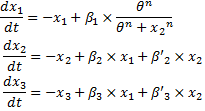|
What about the model?
- When building a model, it is of the utmost importance to present a justification of the choice made along the transposition process from biological reality to mathematical representation. The aim of this section is to introduce a mathematical justification of our choices in the BOB approach.
Short introduction to the criteria
- Using linear equations in a biological system might seem awkards. However, we wanted to check the relevance of this approach. We have been looking for a criterium that would penalize a system that had many parameters, but that would also penalize a system which quadratic error would be too important while fitting experimental values. The goal here is to decide whether, assuming that the experimental data looks like a model based on Hill functions, the linear part of the BOB model is obsolete or not.
- Akaike and Schwarz criteria taken from the information theory met our demands quite well :
Akaike criterion :
Hurvich and Tsai criterion :
Schwarz criterion :
where n denotes the number of experimental values, k the number of parameters and RSS the residual sum of squares.
The best fitting model is the one for which those criteria are minimized.
- It is remarquable that Akaike criterion and Hurvich and Tsai criterion are alike. AICc is therefore used for small sample size, but converges to AIC as n gets large. Since we will work with 20 points for each experiment, it seemed relevant to present both models. In addition, Schwarz criterion is meant to be more penalizing.
Experiment
- As an experiment, we wished to compare the two models presented below :
System#1 : using the linear equations from our BOB approach :
System#2 : using classical Hill functions :
- We made a set of data out of a noised Hill function. In fact, our data set was made by using the same equations as System#2, but we introduced a normal noise for each point. Thus, System#1 is penalized because its RSS will be greater than that of System#2. Nevertheless, System#2 will be more penalized by its number of parameters.
- With Matlab, we run a fitting simulation for each system, and we obtained the RSS. We then evaluated the different criteria for both models. The results are presented below.
| Comparison of the systems for n=20
|
| Criteria
| System#1
| System#2
|
| AIC
| 26.7654
| 32.0035
|
| AICc
| 38.7654
| 168.0035
|
| BIC
| 22.9435
| 24.3596
|
| Comparison of the systems for n=100
|
| Criteria
| System#1
| System#2
|
| AIC
| 169.5495
| 32.1150
|
| AICc
| 171.1147
| 38.5912
|
| BIC
| 172.0100
| 37.0360
|
- Consequently, what have we proved? These results show that:
- Firstly, we may see that the AICc does converge to AIC for greater values of n.
- Then, we may see that, as predicted, System#2 is not more penalized for greater values of n, although System#1 is.
- Furthermore, since the use of more parameters is quite penalizing for a small set of data, and since the criteria are minimized for System#1, the first subsystem of our BOB model is not irrelevant.
- However, since for a larger set of data System#2 minimizes the criteria, these criteria cannot decide whether a model is better than another one, since those criteria are arbitrary. Yet, they may help us find a better compromise between simplification and accuracy.
- One must be careful when building a model, since chosing the number of parameters and deciding how deep one wishes to go into detail, influences the goal and the results of a model. It is therefore important to understand that a model has to be conceived to achieve a precise aim.
- Then, it is always useful to use different models, knowing that each model meets a certain demand. Here, our full model (APE) will be used to present a highly detailed overview of the processes that take place in the system. In the mean time, the BOB approach is a reasonable mean to explore the system quickly.
We mostly used the definition of the criteria given in :
[http://www.liebertonline.com/doi/pdf/10.1089/rej.2006.9.324 K. Kikkawa.Statistical issue of regression analysis on development of an age predictive equation. Rejuvenation research, Volume 9, n°2, 2006.]
|
 "
"


